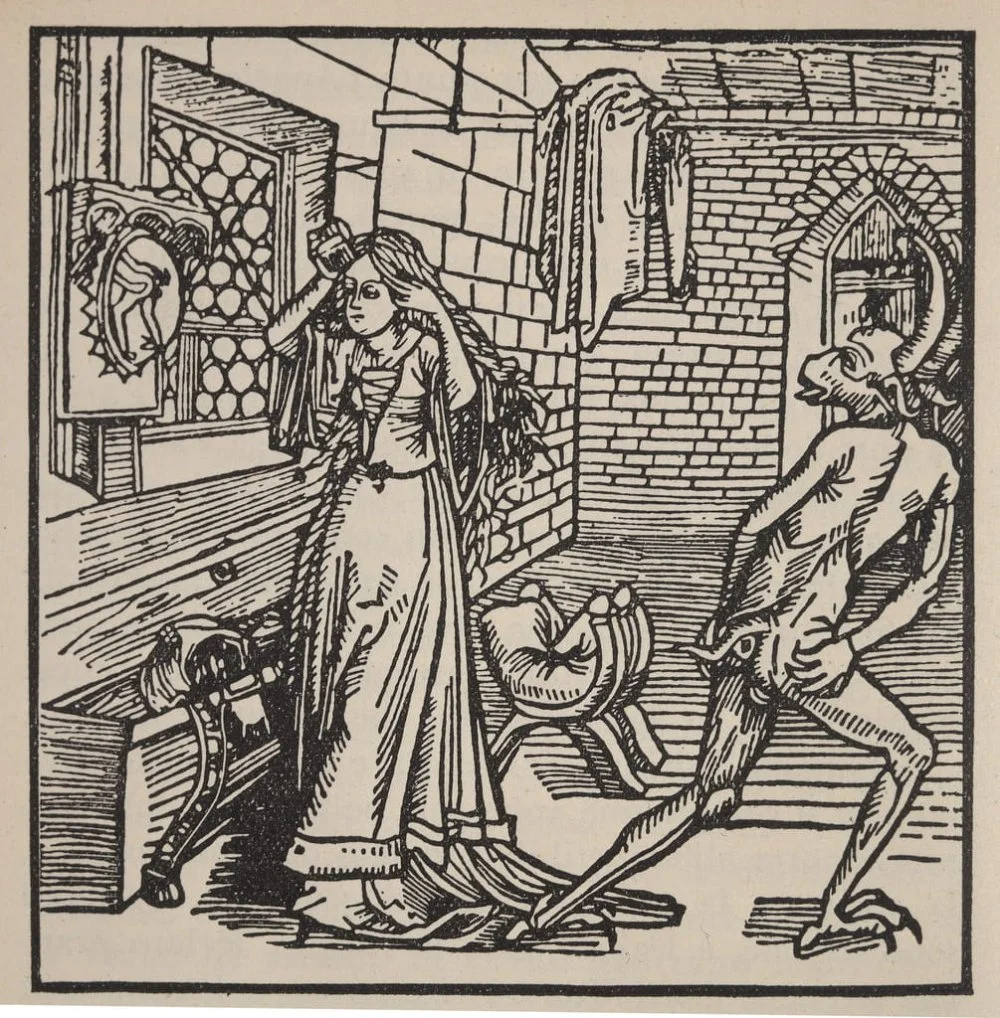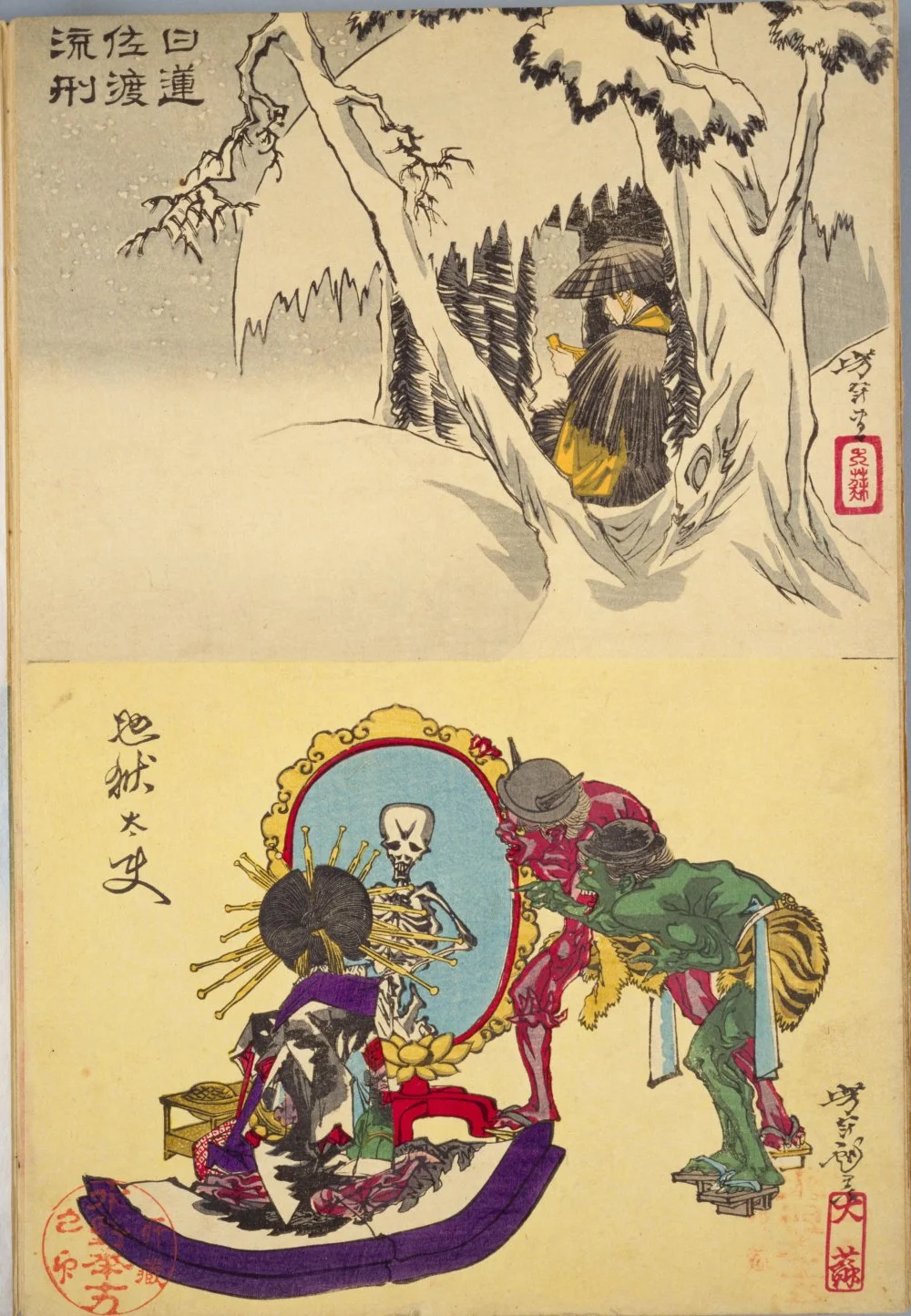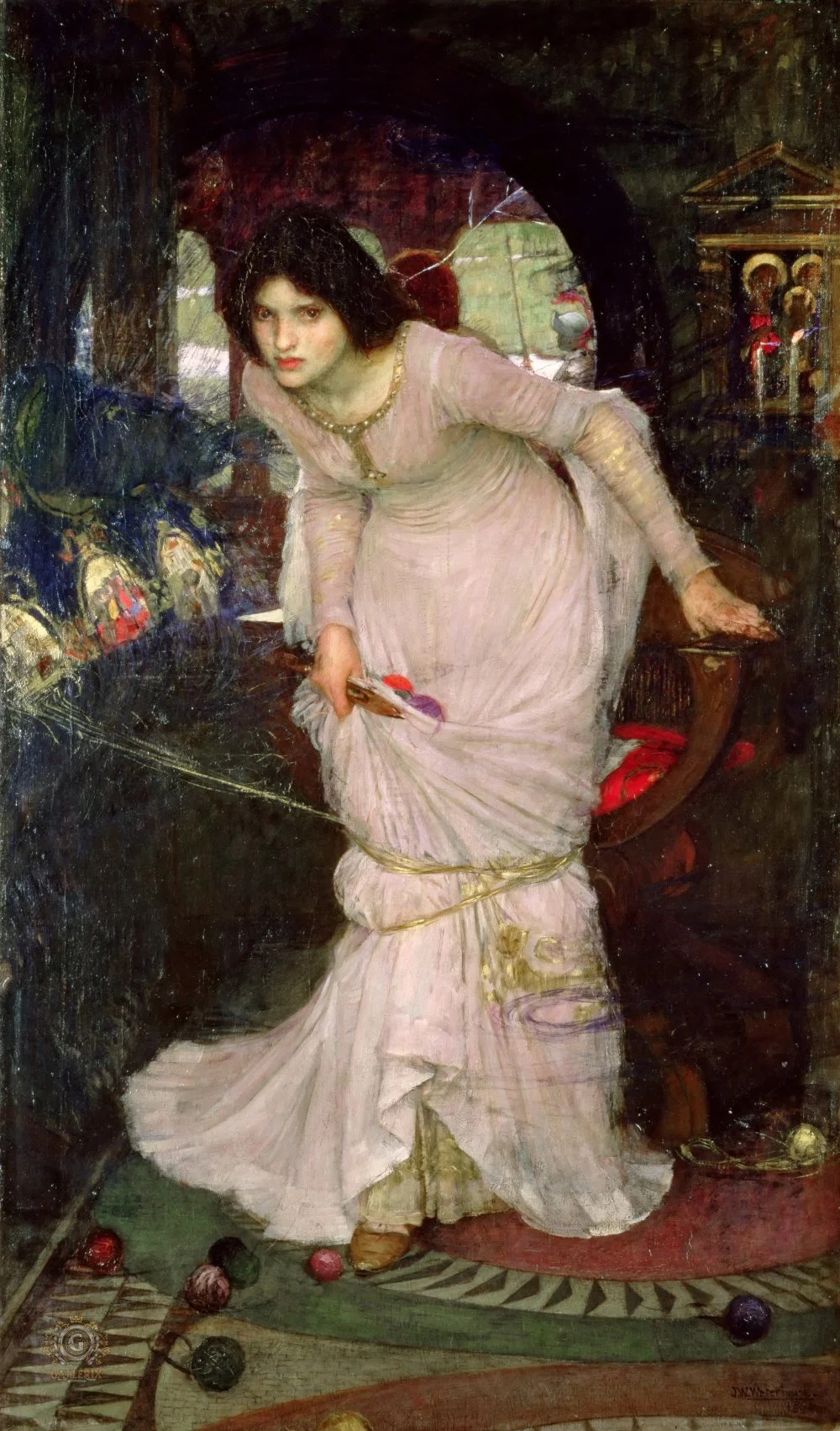Mirrors used to be made of stone, bronze, silver and glass. They could be a cheap utensil even a slave would have or cost a fortune. However, they were always perceived as something that had a dual essence; they were a useful everyday thing and at the same time they were the door connecting our reality with something dangerous.
The mirror as a symbol of Venus, depicted as a circle with a cross, has become a symbol of the feminine in general because mirrors were considered a female thing throughout all cultures and ages. Child dwellers of the late Mesolithic period were buried with obsidian mirrors, young Roman girls were sent off to the other side with a bronze mirror and noble Japanese young ladies were given a polished metal mirror contained inside an expensive box on the day of coming of age.
A woman, a goddess, or a little girl in front of a mirror, are scenes one can see on an Egyptian tomb, in a Renaissance Florentine palace, and on the cover of The Saturday Evening Post (an image that has emerged from the brush strokes of the genius Norman Rockwell, ‘Girl at Mirror’).
The girl contemplating her reflection, and the reflection itself, are both very far from flirting, vanity or fear of the cruelty of passing time. This image has always been much deeper and more important than that for artists and the public alike.
The mirror and I
The mirror test, developed in 1970 by a psychologist Gordon Gallup Jr. is still considered an important criterion that allows to determine the self-awareness of the species. A coloured spot is put on a face or another part of the head of the subject and can only be seen in the mirror. If the subject realises that the reflection in the mirror is themselves they will try to touch, rub off or study the bright spot on themselves and not in the mirror. A young child stops rubbing the mirror and starts hesitantly touching own cheek which has a bright red spot on it at approximately one and a half years old. Apart from humans, apes, dolphins, killer whales, elephants and birds of the corvid family share this ability.
However the ancient Greek shepherd Narcissus didn’t pass the test it would appear. As we know, having seen his reflection in the water he fell in love with it and expired on the shore begging the beautiful image to come out of water. In a way he behaved like a lovebird. These birds cannot stand being alone and are perfectly satisfied by a mirror in their cage which they see as another bird and peacefully interact with it, nudging their glass friend with their beak. A Chinese fairy tale about a peasant who wanted to buy himself a worker but came across a crook that sold him a mirror,
tells of a similar mishap. The peasant saw a big strong man in the mirror and was happy about his purchase until his mother, who saw that he bought an ugly old woman instead of a worker, told him off. However, it is very unlikely that a person that has never seen a mirror may not recognise themselves in one. All of the people of the stone age quickly figured out what mirrors were about upon contact with civilisation, so it is not surprising that small mirrors were the most popular exchange currency.
“We saw each other often and I told him about my trips to the Guinea shores and how easy it is to trade with the locals and acquire gold sand and ivory for some trinkets such as necklaces, knives, scissors axes or little mirrors”. (Daniel Defoe, Robinson Crusoe)
Dangerous Double
If those people who refuse to accept the reflection as themselves did exist, they were not that wrong. This is because what we see in the mirror is not really us but our flat reflection, an image that is very much like us, mimicking our movements and grimaces but very different from us all the same. Different in its two-dimensional nature, in its mirroring. Where we have our left hand our double has the right. This flipping of the reflection seemed especially sinister to preachers of Christian morals who were against mirrors based on the following premise:
1. Mirrors are unreasonably expensive and do not match the requirements of a frugal righteous life.
2. Mirrors encourage vanity, the drive to adorn one’s body and therefore encourage debauchery.
3. Mirrors, always changing left and right, are definitely the invention of the devil because this is just his way of doing things – deceitful turning of everything back to front and inside out.
Two images created in two different worlds are nevertheless very harmonious. The first one is an image which adorns a tractate by Otto von (Ritter) Thoren printed at the end of 15th century called “The Education of Young Ladies”. A young girl brushing her hair admires herself in the mirror but the reflection in the mirror is a shameless backside of a demon grimacing next to this beauty.

Albrecht Durer. The Demon of Vanity and the Coquette. 1498/Alamy
The second image is the work of a Japanese artist Taiso Yoshitoshi called ‘Hell Courtesan’ (‘Jigoku Dayu’) (1882) where a beautiful young woman dressed in fine clothes sits in front of the mirror and sees a reflection of a skeleton wearing her clothes.

Taiso Yoshitoshi. Courtesan from hell Jigokudayu, looking in the mirror. 1882
It must be difficult to find two people who would understand each other any less than a medieval German artist and a Japanese painter, yet here they were thinking alike: mirrors can lie but they can open up the scary truth that is invisible to world.
Our double, the doppelganger, our frightening twin, is the one we really see in the mirror and the one we mistake for our compliant reflection.
People do love mirrors but they also scare us witless sometimes. Of course a human being is not a little kitten that hisses and arches it’s back, but we do have some instincts in common with that kitten. The image of an independent sinister reflection, the mirror double that is trying to penetrate our world and scare us is well loved by the authors of the mystic genre of every calibre.
The door to the other worlds
`It’s not just our reflection which is flipped in the mirror, it’s the entire world.’
Lewis Carroll knew where to send his Alice in order to describe inverted reality, together with logic and cause and effect, with a clear conscience. However, one doesn’t need to be an Oxford professor of mathematics in order to suspect mirrors of being the most convenient door into the spirit world. This idea was universal among all users of mirrors over thousands of years. There was a lot of superstition surrounding mirrors. The tradition to cover mirrors during the mourning period was practiced Hebrews observing shivah,i
Fortune telling in front of the mirror, magic rituals with mirrors, the fortune teller’s crystal ball, which is basically also a mirror…it is difficult to find any other object that is surrounded by secrets and mysticism as the mirror.
A cracked or broken mirror is a very bad omen and wars about upcoming misfortunes in the real world, at least for the owner of the mirror, as the mirror world is closely connected to them.
“The mirror crack’d from side to side
“The curse is come upon me” – cried
Alfred, Lord Tennyson “The Lady of Shalott”
The lady forms the ancient legend glorified by the English poet, where she could only see our world through the mirror as reality was poison for her. She changed history, weaving her visions from the mirror into the tapestry and dies when the mirror breaks.

John Waterhouse. The Lady of Shalott looking at Lancelot. 1894/Wikimedia Commons
Stone, metal and glass
The better and more precise the mirrors became, the more fear the invoked.
The most ancient of mirrors (well after a bowl of water) were made of stone. Obsidian, jet stone, black marble and other dark and shiny stones able to have smooth shiny slivers with a reflective surface. Surprisingly enough stone mirrors lasted quite long, even when the real modern type mirrors were widely used by people.
This is what Sabine Melchior-Bonnet writes in her book “The Mirror: A History”: “Monsieur Duplessis, travelling with the purpose of inspecting mines thought himself incredibly lucky when he found 5 excellent jet stone mirrors at one of the stalls and immediately bought them for his wife. He wrote in a letter to his wife that she should keep the biggest mirror because “one comes across such items extremely rarely and no one has ever seen such beauty”.
Monsieur Duplessis bought the jet stone mirrors at the very end of the 16th century when large Venetian mirrors were already available (at least to those with money), bet he valued the jet stone mirrors as works of art. Reflection in a piece of black stone is not the same as a reflection in the mirror; different contrast, different colours, it’s a live picture which also smooths any imperfections thanks to its pleasant blurring and dark background.
However, the weight and rarity of perfectly smooth stones and the difficulty in polishing them all led to stone mirrors being used more often to adorn the walls in wealthy homes and with the emergence of metals copper and later bronze mirrors started being used for everyday needs. Now, when we see these mirrors in museums we marvel at the fact that anyone managed to reflect in them at all, as they are so covered with patina. However, provided that a bronze mirror is looked after and regularly polished (with felt and crushed chalk for example), it serves its purpose quite well, helping with plucking eyebrows, putting on eye makeup, getting rid of a small spot or pull out a grey hair – all of these things were successfully executed by ancient beauties with the help of their metal mirrors.

A bronze mirror depicting the Judgement of Paris. 4th century BC/Wikimedia Commons
Glass mirrors have been known at least since the times of ancient Rome. To quote Sabine Melchior-Bonnet: ”Glass mirrors that were discovered during these excavation works date no earlier than the third century AD. Several were found and were quite well preserved, especially in Egypt, Gaul (Reims), Asia Minor and Germany. Admittedly their size is not that great, ranging from two to seven centimetres in diameter, so they can’t have been very comfortable to use, which in turn suggests that they may have most likely been used as amulets and jewellery and not mirrors. Excavations in Antinoopolis gave archaeologists a rich crop of small convex mirrors, with quite a rough finish and coated with a layer of lead on the back. One of these mirrors was inserted into a plaster cast frame, the second one, found in the hand of a little girl, had a metal frame with a small crown on top. The glass, slightly coloured, turned out convex because it was due to being created using a glass blowing tube.”
For hundreds of years that followed mirrors were made using the same labour-intensive method. Melted lead or a mixture of low melting point metals were poured onto the bottom of a blown bubble and once cooled the part with poured metal would be cut off from the bubble resulting in a very convex mirror. We can see a mirror like that on the “Arnolfini Portrait” by Van Eyck.

Jan van Eyck. Arnolfini Portrait. 1434/Wikimedia Commons
Those mirrors were very expensive, gave a very distorted reflection and were quite small as the size of a glass sphere that even the most experienced glass blower could blow out were still limited. Therefore, the bronze mirrors had many years of life left yet.
Only in 15-16th centuries the magnificent Venetian mirrors made from clear glass and covered with a mixture of bronze, mercury and silver started outperforming their metal counterparts so much that the latter started being rejected more and more, mostly by the rich as these Venetian pieces were inexcusably expensive. So much so that they were mainly exported not to the West, but to the East where there were more rich buyers.
“It is known that there was a hall inside a palace in Isfahan that was adorned by mirrors, and in Lahore the walls of the private chambers of a local ruler were coated in gold and had magnificent venetian mirrors hanging on them, covering the entire perimeter of the living quarters” – writes Sabine Melchior-Bonnet.
Venetian craftsmen guarded the secret of their glass more than their own life (quite literally, as leaving Venice was punishable by death for the craftsman and his family, and the same punishment was applicable in the event of any proof that a craftsman had been in contact with “spies”). During the years of the glass and mirror monopoly in the 14th-16th centuries Venice became the richest city in the world and sprouted numerous castles. However, the craftsmen in other regions were putting a lot of effort into their work in order to discover the secrets of glass craftsmanship independently and gradually in Bohemia, Flandria and Latharingia they came to some understanding of how to make the glass very clear, how to roll it to create that smooth level surface and how to coat it with a thin layer of amalgam. Large mirrors remained more expensive than gold by weight for a long time yet, but the small pocket mirrors were widely bought even by the peasant girls during trade fairs by the 15th-16th century, and soon the Venetians were displaced from the mirror market by other manufacturers: The French took Europe from them, and Asia was taken by the glass workshops of the Ottoman Empire. Istanbul glass craftsmen were stationed around the area of the Tekfur palace, and a traveller of the 17th century wrote that over a thousand glass craftsmen worked in Istanbul at that time and glass items, including good quality mirrors were being sold in 364 stalls.
Once in the black mirror
The most dramatic and relatively futuristic British series “Black Mirror” that first aired in 2014, is full of worries about the future and combines individual’s rights and the rights of its digital double, where the trans humanitarian changes of the human body create a conflict with the base instincts and passions, and where technological advances go hand in hand with moral decay. Let us leave the bleak vision of the future to the authors’ conscience and look at the title. The black mirror is of course the screen. The screen of a laptop, a tablet or a smartphone. The authors of this series played on the mirror effect of the black glass, hinting that everything we see online, in films and on social media is our own reflection in the end. The reflection of humankind on the whole and of an individual person as well. Of course, they were right about this. First photographs, and then videos – these are also reflections of sorts. They are images of events, live images taken from reality and stored on tape or digitally.
Never before was a person able to examine themselves and the surrounding world as carefully as they have managed to do with the help of this giant mirror that the Lady of Shalott could not even dream of. She only managed to see some of Cameloti
Today anyone who turns on a screen can see our entire world zooming in and out, any spot on any’s king’s nose, any incident in detail and any thought during its development.
And if we don’t quite like what is reflected in this mirror we know how to fix it. Theoretically.
What to read
1. Sabine Melchior-Bonnet “The Mirror: A History”:Novoe Literaturnoe Obozrenie, 1994
2. Evliya Celebi “The book of travels” “Nauka” 1979 C
